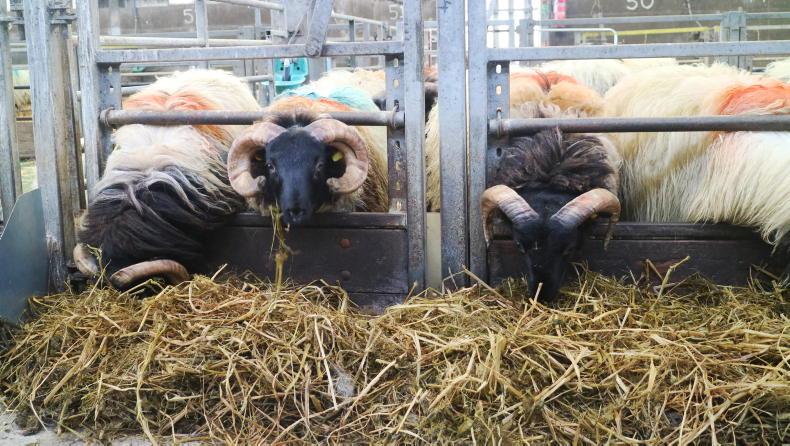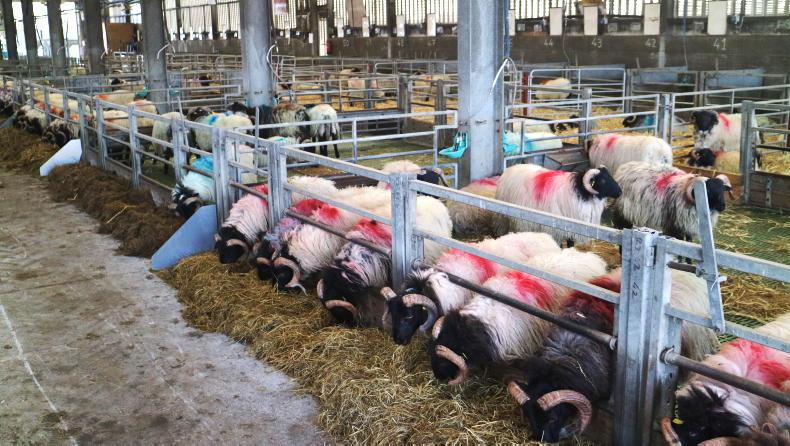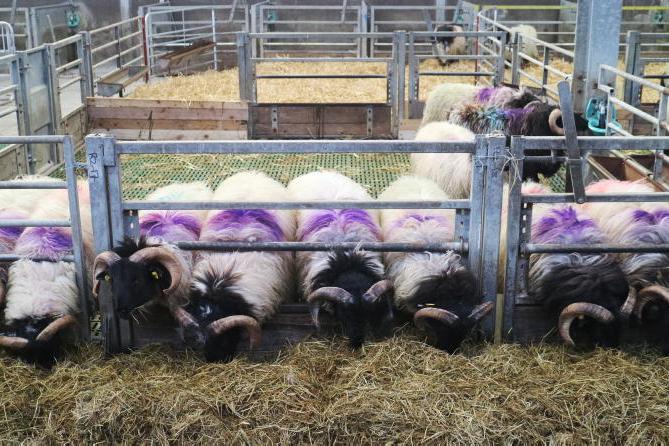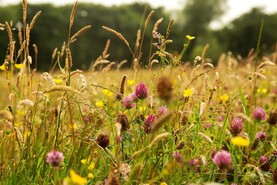Establishing indoor finishing systems for finishing hill lambs in an organic production system with reduced concentrate input is not likely to be straightforward. This prediction is based on the findings of year one of a study evaluating finishing systems for organic lambs.
As will be discussed in detail below, just 43% of lambs were drafted for slaughter in the most successful treatment with zero lambs in the poorest performing treatment.
The preliminary findings of the study undertaken in Teagasc Mellows Campus Athenry, and which aims to help reduce the leakage of lambs in to conventional finishing systems, were presented at Sheep 2025.
The aim of the indoor finishing treatments was to evaluate a range of forage and concentrate-based finishing diets including high-quality grass silage and concentrates, high-quality red clover silage and concentrates and a combi / wholecrop forage-based finishing diet. The combi crop used in 2024 was peas, barley and oats ensiled in 4x4 round bales.
The male Scottish Blackface lambs were managed under organic conditions with an ample straw lie-back provided behind a slatted feed area in the passageway in the main research unit. Lambs were weighed fortnightly and in addition to daily liveweight gain, aspects such as intake, animal eating behaviour etc were monitored.
Lambs were afforded an acclimatisation period before the study period commenced. They were offered ad-lib forage and 500g daily of a standard organic concentrate formulation. The starting weight for lambs on the trial was about 29kg with a target drafting liveweight of 44kg and a satisfactory fat score.
The lowland and hill studies are being overseen by Philip Creighton, Head of Sheep Enterprise and researcher Frank Campion. The areas of the farm allocated to the studies have been farmed organically since 2022.
Table 1 details the main findings. Lambs on the grass silage diet recorded the highest level of performance at 119g per day, with lambs on the red clover silage treatment next up at 95g/day. This is in sharp contrast to lambs on the wholecrop silage diet which gained just 45g daily.
Lambs were removed from the treatment after 93 days when it was clear that there was no hope of finishing any lambs on this treatment. The addition of wholecrop silage to the concentrate component of the diet did not significantly enhance average daily gain.
Frank Campion, lead researcher working on the study said that when offered the wholecrop silage lambs sorted through the cereal component and once this was consumed intake of the straw fraction was low with a high percentage of feed uneaten. With performance driven by feed intake such lambs were always going to struggle to perform.
It was also found that for lambs to finish on an indoor system efficiently they need to be starting from a higher starting weight to ensure lambs can be brought to the required drafting weight and fat score. This is just the first year of the study and a number of metrics will be tweaked to try and establish finishing systems capable of achieving higher daily liveweight gain.
The study above is part of the GROFarmS project which stands for Growing Resilient Organic Farming Systems. Funded by the Department of Agriculture, Food and the Marine, the project undertaken by Teagasc in collaboration with University College Dublin aims to evaluate finishing options and management systems for finishing organic hill and lowland lambs taking into account effects on animal performance, environmental impact and economic returns.
The second element of the project includes a lowland lamb finishing systems study where a comparison of two contrasting forage-based lamb finishing systems will be investigated – a grass legume based production system and a grass legume and forage crop production system.
In addition to lamb performance being evaluated in terms of growth rate, parasite challenge and finishing patterns in the lambs, the effect of forage type on feed supply, utilisation and quality will also be explored. Also, the effect of finishing system on overall system environmental and economic performance will be evaluated.
The lowland component systems include 100 ewes plus their lambs stocked at a relatively high stocking rate of 7.5 ewes/ha. This includes the forage area and winter feed must be produced within each farmlet. Ewe type is a Belclare x Texel cross ewe mated back to Texel sires lambing from early March.
The average litter size in 2024 was recorded in the region of 1.56 lambs per ewe joined. All sheep are managed to strict organic principles with any health treatments as per the flock health plan and withdrawal dates doubled / tripled as required.

No lambs were drafted from the wholecrop silage / concentrate treatment.
Lamb performance pre-weaning was recorded at 240g/head/day. Post-weaning lambs were divided and assigned to their finishing group. The results are summarised in Table 1.
Pasture production was good with 6.99t of dry matter produced while 4.72t DM/ha was produced by the hybrid brassica crop. All lambs were finished off the latter treatment with lambs on the grass legume based treatment requiring an average of 14kg concentrate supplementation.

The lambs were all managed as per organic housing specifications.
It will be interesting to see how the systems perform as they progress further through an organic production system and if legumes and available organic nutrients will be sufficient to maintain the volume of forage produced.
Hill lamb finishing systems will also explore outdoor finishing systems. Extensive research has been carried out in recent years evaluating the potential role of forage crops in finishing hill lambs.
This has delivered relatively positive results in a conventional system so it will be interesting to see if this can be replicated using forage rape and hybrid brassicas in an organic management system.
Establishing indoor finishing systems for finishing hill lambs in an organic production system with reduced concentrate input is not likely to be straightforward. This prediction is based on the findings of year one of a study evaluating finishing systems for organic lambs.
As will be discussed in detail below, just 43% of lambs were drafted for slaughter in the most successful treatment with zero lambs in the poorest performing treatment.
The preliminary findings of the study undertaken in Teagasc Mellows Campus Athenry, and which aims to help reduce the leakage of lambs in to conventional finishing systems, were presented at Sheep 2025.
The aim of the indoor finishing treatments was to evaluate a range of forage and concentrate-based finishing diets including high-quality grass silage and concentrates, high-quality red clover silage and concentrates and a combi / wholecrop forage-based finishing diet. The combi crop used in 2024 was peas, barley and oats ensiled in 4x4 round bales.
The male Scottish Blackface lambs were managed under organic conditions with an ample straw lie-back provided behind a slatted feed area in the passageway in the main research unit. Lambs were weighed fortnightly and in addition to daily liveweight gain, aspects such as intake, animal eating behaviour etc were monitored.
Lambs were afforded an acclimatisation period before the study period commenced. They were offered ad-lib forage and 500g daily of a standard organic concentrate formulation. The starting weight for lambs on the trial was about 29kg with a target drafting liveweight of 44kg and a satisfactory fat score.
The lowland and hill studies are being overseen by Philip Creighton, Head of Sheep Enterprise and researcher Frank Campion. The areas of the farm allocated to the studies have been farmed organically since 2022.
Table 1 details the main findings. Lambs on the grass silage diet recorded the highest level of performance at 119g per day, with lambs on the red clover silage treatment next up at 95g/day. This is in sharp contrast to lambs on the wholecrop silage diet which gained just 45g daily.
Lambs were removed from the treatment after 93 days when it was clear that there was no hope of finishing any lambs on this treatment. The addition of wholecrop silage to the concentrate component of the diet did not significantly enhance average daily gain.
Frank Campion, lead researcher working on the study said that when offered the wholecrop silage lambs sorted through the cereal component and once this was consumed intake of the straw fraction was low with a high percentage of feed uneaten. With performance driven by feed intake such lambs were always going to struggle to perform.
It was also found that for lambs to finish on an indoor system efficiently they need to be starting from a higher starting weight to ensure lambs can be brought to the required drafting weight and fat score. This is just the first year of the study and a number of metrics will be tweaked to try and establish finishing systems capable of achieving higher daily liveweight gain.
The study above is part of the GROFarmS project which stands for Growing Resilient Organic Farming Systems. Funded by the Department of Agriculture, Food and the Marine, the project undertaken by Teagasc in collaboration with University College Dublin aims to evaluate finishing options and management systems for finishing organic hill and lowland lambs taking into account effects on animal performance, environmental impact and economic returns.
The second element of the project includes a lowland lamb finishing systems study where a comparison of two contrasting forage-based lamb finishing systems will be investigated – a grass legume based production system and a grass legume and forage crop production system.
In addition to lamb performance being evaluated in terms of growth rate, parasite challenge and finishing patterns in the lambs, the effect of forage type on feed supply, utilisation and quality will also be explored. Also, the effect of finishing system on overall system environmental and economic performance will be evaluated.
The lowland component systems include 100 ewes plus their lambs stocked at a relatively high stocking rate of 7.5 ewes/ha. This includes the forage area and winter feed must be produced within each farmlet. Ewe type is a Belclare x Texel cross ewe mated back to Texel sires lambing from early March.
The average litter size in 2024 was recorded in the region of 1.56 lambs per ewe joined. All sheep are managed to strict organic principles with any health treatments as per the flock health plan and withdrawal dates doubled / tripled as required.

No lambs were drafted from the wholecrop silage / concentrate treatment.
Lamb performance pre-weaning was recorded at 240g/head/day. Post-weaning lambs were divided and assigned to their finishing group. The results are summarised in Table 1.
Pasture production was good with 6.99t of dry matter produced while 4.72t DM/ha was produced by the hybrid brassica crop. All lambs were finished off the latter treatment with lambs on the grass legume based treatment requiring an average of 14kg concentrate supplementation.

The lambs were all managed as per organic housing specifications.
It will be interesting to see how the systems perform as they progress further through an organic production system and if legumes and available organic nutrients will be sufficient to maintain the volume of forage produced.
Hill lamb finishing systems will also explore outdoor finishing systems. Extensive research has been carried out in recent years evaluating the potential role of forage crops in finishing hill lambs.
This has delivered relatively positive results in a conventional system so it will be interesting to see if this can be replicated using forage rape and hybrid brassicas in an organic management system.








 This is a subscriber-only article
This is a subscriber-only article










SHARING OPTIONS: